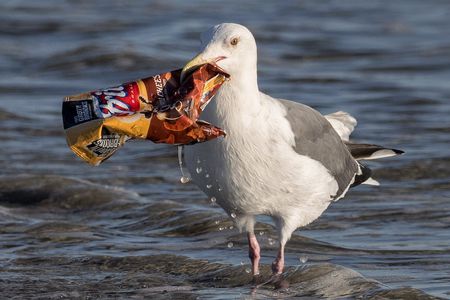Plastic pollution is believed to pose serious health risks to wildlife, and a new report presented to governments at the 7th Session of the Meeting of the Parties (MOP7) to the African-Eurasian Migratory Waterbird Agreement (AEWA) that held from December 4 to 8 in Durban, South Africa, has shown how migratory waterbirds are affected. However, increasing public awareness and changing habits have the potential to turn the tide.

According to the report, of the 254 species covered by the AEWA, more than 40 per cent have been shown to interact with plastics: 22 per cent contain ingested plastic, 31 per cent were entangled in plastic debris, and 8 per cent use plastic items in their nests.
“The growing scourge of plastic pollution across our planet is affecting waterbirds in many ways. When ingested, it can lead to malnutrition and even starvation. Plastic floating in the oceans, along rivers or stranded along our shorelines and in wetlands can cause injuries, impede mobility and cause birds to drown,” said Jacques Trouvilliez, Executive Secretary of AEWA.
One way in which plastic affects waterbirds is through ingestion. Birds often mistake plastic for food but cannot digest it. Plastic items can become lodged in the digestive tract, either blocking the throat and causing choking, or accumulating and filling in the stomach which can lead to malnutrition and starvation. As an example of this, approximately half of all phalaropes, a small migratory shorebird species, have been found with plastic in their digestive systems. In many cases these birds live in remote locations far from humans, but the collection of plastics in the environment means that even they are susceptible.
Another way in which plastics pose a danger to waterbirds is through entanglement. Because plastic does not decompose, floating items such as fishing gear, long filaments and ring-shaped items threaten waterbirds with injuries, impeded mobility and drowning. The number of seabird species affected in this manner has tripled since the mid-1990s. Northern Gannets, an AEWA-listed seabird species, are particularly prone to entanglement with old fishing gear as they follow fishing vessels at sea.
Lastly, microplastics are an increasing contributor to the scourge of plastic pollution. These originate either from small plastics such as microbeads or from degradation of larger items. Microplastics are commonly ingested by prey species which are then consumed in turn by predatory birds.
The report “Waterbirds and Plastics”, which was the first of its kind presented to governments at AEWA MOP7 notes a geographical bias towards Europe and South Africa in studies concerned with waterbirds and plastic pollution.
“It is important that studies elsewhere in the African-Eurasian Flyway fill the knowledge gaps, so we better understand thefull impact of plastics on all waterbirds within the geographic range of AEWA. At the same time, we cannot wait for these studies to fill knowledge gaps but must act now to address the problem globally and collectively across all the world’s flyways,” said Jacques Trouvilliez, Executive Secretary of AEWA.
AEWA MOP7 has taken the actions recommended in the report and included them in a resolution on seabird conservation for Parties to consider for adoption at the final day of the meeting. This will hopefully generate action across much of the African-Eurasian flyway in addressing the issue of plastic pollution. The announcement was also made during plenary that the theme for World Migratory Bird Day 2019 will be “Protecting birds from plastic pollution”.
Andrew de Blocq, a penguinologist from the conservation NGO BirdLife South Africa who attended AEWA MOP7, said: “Plastic pollution is a growing threat to waterbirds and seabirds, and we as conservationists are extremely concerned about it. However, the silver lining is that people around the world are fast becoming aware of the consequences for wildlife, and we are seeing a culture change associated with a movement away from single-use plastic items and toward a more conscious, eco-friendly lifestyle.”
